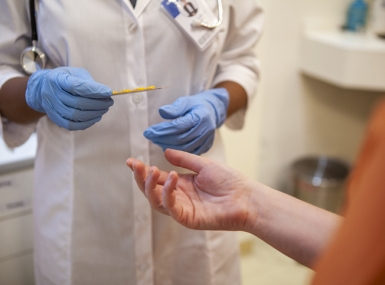Protect Funding for Core Local Public Health Services and Prevention Programs

Author

Blaire Bryant
Upcoming Events
Related News
Action Needed
Urge your members of Congress, especially those who serve on the U.S. House and Senate Appropriations Committees, to protect and increase funding for local public health services and prevention programs made possible by the Prevention and Public Health Fund (PPHF) in Fiscal Year (FY) 2025.
Background
Counties support the majority of America’s approximately 3,300 local health departments and protect our residents’ health, safety and quality of life. Nearly seventy percent of local health departments are county-based and another 8 percent serve multiple counties. Local health departments provide immunizations; conduct surveillance to detect and monitor emerging infectious diseases; protect the food and water supply; and prepare for and respond to disasters, acts of bioterrorism and other health emergencies. In addition, local health departments work with community partners to help prevent the leading causes of death and disability and reduce health care costs.
Direct federal investments are responsible for nearly 25 percent of local health departments’ revenue. According to the National Association of County and City Health Officials (NACCHO), local health departments workforce grew by 19 percent between 2019 and 2022 after major decreases since 2008; this increase was likely impacted by additional funding opportunities during the COVID-19 public health emergency declaration . Dedicated funding sources such as the PPHF are critical to helping counties support core local public health programs such as immunizations and chronic disease prevention. PPHF also invests in new and innovative programs tailored to the unique health problems facing our communities, including the underlying social determinants of health.
Local public health programs are essential for preventing chronic diseases, including heart disease, cancer, stroke and diabetes. Heart disease and stroke alone cost the U.S. health care system $254 billion per year. Since the inception of the PPHF in FY 2010, new public health threats have emerged- such as substance use disorders and the suicide epidemic, infectious disease outbreaks and increases in chronic illnesses- and federal resources have not kept pace.
Despite funding essential public health work, the PPHF has already been cut by over $11.85 billion from FY 2013 to FY 2027. Further cutting PPHF funding, especially without increasing funding for local public health programs through regular appropriations, would negatively impact local public health departments already strained by having to respond to illness outbreaks like the COVID-19 pandemic, the ongoing opioid crisis, and other emerging threats while maintaining core operations to keep residents healthy and safe.
Key Talking Points
- The PPHF allows local and state health departments to tailor community solutions. States and localities face unique public health needs and challenges that call for innovative and community-driven solutions. In FY 2024, the PPHF funded nearly all of the Preventive Health and Health Services Block Grant, with an investment of $160 million. This program provides state and local health departments the flexibility to solve problems unique to their residents, while still being held accountable for demonstrating the local, state and national impact of the investment. States develop health plans, report their activities to Centers for Disease Control (CDC) and implement prevention and treatment solutions for populations in need.
- The PPHF supports cost-effective and life-saving immunizations. Immunizations are one of the most cost-effective public health interventions, saving an estimated 42,000 lives and preventing 20 million cases of disease for babies born in a given year with a return on investment of $10.20 for every $1 invested, according to the CDC. In FY 2024, the PPHF contributed $681.93 million to the CDC’s Immunization Program. This program provides funds to purchase vaccines for at-risk populations and immunization program operations, including support for implementing billing systems for immunization services at public health clinics to sustain high levels of vaccine coverage.
- The PPHF funds early and rapid detection of disease and injury. Local public health infrastructure is crucial to controlling infectious diseases like tuberculosis, once the leading cause of death in the U.S., and responding to outbreaks like salmonella. In FY 2024, at a total of $40 million, the PPHF funded all of CDC’s Epidemiology and Lab Capacity (ELC) Cooperative Agreement Program. This is a single grant vehicle for program initiatives that strengthen state and local efforts to detect, track and respond to known infectious disease threats in communities and maintain counties’ core capacity to be the eyes and ears on the ground to detect new threats as they emerge. The five-year performance period for ELC began in August 2024 and funds 65 jurisdictions.
Resource
The County Role in Public Health

Related News

NACo offers new Medicaid resources as Congress advances Budget Resolutions with major Medicaid reform implications
On April 10, the U.S. House of Representatives voted to adopt a Senate-passed budget resolution, marking the next step in the budget reconciliation process. The proposed funding levels therein represent significant potential cost shifts to counties, particularly in the area of Medicaid financing. To help county leaders understand what’s at stake, NACo has developed two new resources.

County Countdown – April 21, 2025
Every other week, NACo's County Countdown reviews top federal policy advocacy items with an eye towards counties and the intergovernmental partnership. This week features the ARPA reporting deadline, a budget reconciliation update and more

U.S. House reintroduces legislation to address the Medicaid Inmate Exclusion Policy
Two bipartisan bills aimed at addressing the Medicaid Inmate Exclusion Policy (MIEP) were recently reintroduced in the U.S. House of Representatives.